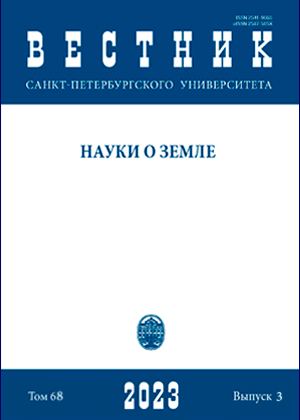The experience of calculating distances between different types of settlements in Russia to assess the range of population migration
DOI:
https://doi.org/10.21638/spbu07.2023.301Abstract
The problem of measuring distances in migration is not trivial, but important, for example, for delimiting the concepts of population migration and housing mobility.
In conditions of limited access to detailed spatial data, researchers solve this issue in different ways. Only a few countries, such as Sweden, have the ability to calculate migration distances between point locations using Euclidean distance (in a straight line). In this article, as applied to Russia, the measure of correspondence between Euclidean distances and real distances along transport routes is investigated. For this purpose, 3407 pairs of distances were calculated for randomly selected 23 municipal districts of Russia directly and along transport routes - roads. Also, 411 pairs of distances were calculated for settlements with no auto connection, using air traffic. These distances give an idea of the migrations of different distances in Russia.
As a result, for hypothetical resettlements within the selected municipal districts, real road distances exceed Euclidean distances by 51%. For resettlements between the centers of districts and urban districts within the region, this indicator exceeds 40%, and for interregional resettlements, the differences are 33%. The air service used “straightens” the distances, but even taking it into account, the real distances (mainly long-range, interregional) exceed the Euclidean ones by 28.5%. The calculations performed to give an idea of the deviations of real, transport distances from the relatively easy-to-calculate Euclidean ones, which can be used in the analysis of migration distances in Russia.
Keywords:
municipalities, population migration, range, regions of Russia, Euclidean distance, transport distance
Downloads
References
Манвелидзе, А. Б. (2018). Сравнение пассажирских перевозок авиационным и железнодорожным транспортом. Стратегические решения и риск-менеджмент, 1, 88-101.
Мкртчян, Н. В. и Карачурина, Л. Б. (2004). Дальность межрайонной миграции в России: тенденции и современная ситуация. В: А. Г. Коровкин, под ред., Научные труды ИНП РАН. М.: МАКС Пресс, 488-504.
Неретин, А. С. (2018). Транспортное положение и доступность территорий Европейской России. Дис. … канд. геогр. наук. М.
Неретин, А. С., Зотова, М. В., Ломакина, А. И., Тархов, С. А. (2019). Транспортная связность и освоенность восточных регионов России. Известия РАН. Серия географическая, 6, 35-52. https://doi.org/10.31857/S2587-55662019635-52
Тархов, С. А. (2018). Транспортная освоенность территории. Вестник Московского университета. Серия 5. География, 2, 3-9.
Татевосов, Р. В. (1971). Анализ дальности миграций городского населения СССР и некоторые вопросы моделирования и прогнозирования миграций. Автореф. дис. … канд. геогр. наук. М.
Татевосов, Р. В. (1973). Исследование пространственных закономерностей миграции населения. В: Т. В. Рябушкин, под ред., Статистика миграции населения. М.: Статистика, 35-48.
Численность населения Российской Федерации по муниципальным образованиям на 1 января 2022 г. (статистический бюллетень) (2022). М.: Росстат.
Boyle, P. and Flowerdew, R. (1997). Improving Distance Estimates between Areal Units in Migration Models. Geographical Analysis, 29 (2), 93-107.
Clark, W. A. V. (2020). Human Migration (1986). In: I. Grant, ed., reprint. WVU Research Repository.
Hipp, J. R. and Boessen, А. (2017). The Shape of Mobility: Measuring the Distance Decay Function of Household Mobility. The Professional Geographer, 69 (1), 32-44.
Lomax, N., Norman, P., Darlington-Pollock, F. (2021). Defining distance thresholds for migration research. Population, Space and Place, 27 (4). https://doi.org/10.1002/psp.2440
Long, L., Tucker, C. J., Urton, W. L. (1988). Migration distances: An international comparison. Demography, 25, 633-640.
Newbold, K. B. and Peterson, D. A. (2001). Distance weighted migration measures. Papers in Regional Science, 80, 371-380.
Niedomysl, T., Ernstson, U., Fransson, U. (2017). The accuracy of migration distance measures. Population, Space and Place, 23 (1), e1971. https://doi.org/10.1002/psp.1971
Niedomysl, T. and Fransson, U. (2014). On distance and the spatial dimension in the definition of internal migration. Annals of the Association of American Geographers, 104, 357-372. https://doi.org/10.1080/00045608.2013.875809
Olsson, G. (1965). Distance and Human Interaction: A Review and Bibliography. Regional Science Research Institute: Philadelphia.
Rogerson, P. A. (1990). Buffon’s needle and the estimation of migration Distances. Mathematical Population Studies, 2 (3), 229-238. https://doi.org/10.1080/08898489009525308
Stillwell, J., Bell, M., Ueffing, P., Daras, K., Charles-Edwards, E., Kupiszewski, M., Kupiszewska, D. (2016).Internal migration around the world: Comparing distance travelled and its frictional effect. Environment and Planning А, 48 (8), 1657-1675. https://doi.org/10.1177/0308518X16643963
Stillwell, J., Daras, K., Bell, M. (2018). Spatial Aggregation Methods for Investigating the MAUP Effects in Migration Analysis. Applied Spatial Analysis and Policy, 11, 693-711. https://doi.org/10.1007/S12061-018-9274-6
Stillwell, J., Daras, K., Bell, M., Lomax, N. (2014). The IMAGE studio: A tool for internal migration analysis and modelling. Applied Spatial Analysis and Policy, 7, 5-23.
Stillwell, J. and Thomas, M. (2016). How far do internal migrants really move? Demonstrating a new method for the estimation of intra-zonal distance. Regional Studies, Regional Science, 3 (1), 28-47. https://doi.org/10.1080/21681376.2015.1109473
Williams, A. M. and Baláž, V. (2012). Migration, Risk, and Uncertainty: Theoretical Perspectives. Population, Space and Place, 18 (2), 167-180. https://doi.org/10.1002/psp.663
Zax, J. S. (1994). When is a move a migration? Regional Science and Urban Economics, 24 (3), 341-60.
Downloads
Published
How to Cite
Issue
Section
License
Articles of "Vestnik of Saint Petersburg University. Earth Sciences" are open access distributed under the terms of the License Agreement with Saint Petersburg State University, which permits to the authors unrestricted distribution and self-archiving free of charge.






